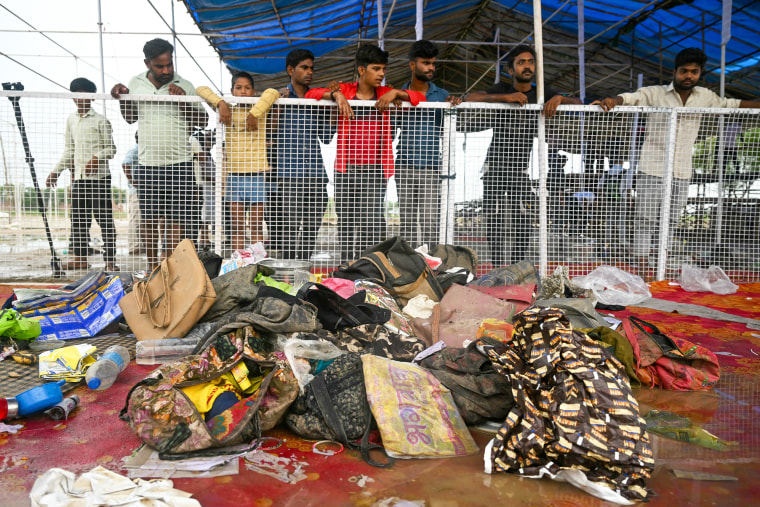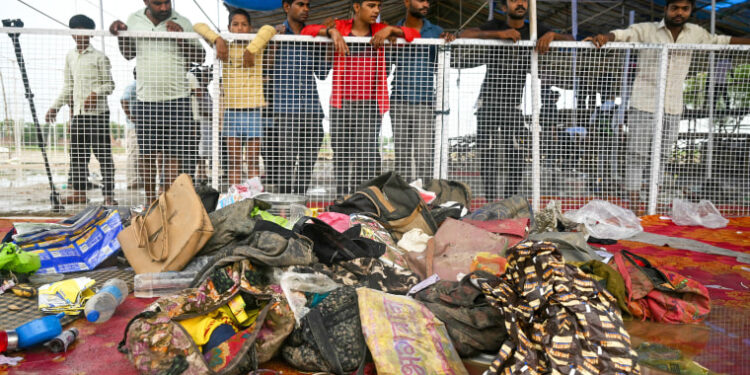At least 116 people, all but one of them women and children, were killed in a stampede at a religious event in northern India, authorities said.
Hundreds of thousands of people had gathered at the Tuesday event, which was held amid sweltering heat in a makeshift tent in the Hathras district of Uttar Pradesh state, about 125 miles southeast of the Indian capital, New Delhi.
The stampede began at the end of the event when a crowd of devotees rushed to touch the Hindu preacher hosting it as he left the stage, the state’s chief minister, Yogi Adityanath, said late Tuesday in a video posted on X.
Adityanath announced compensation of $2,400 each for the families of the deceased and $600 for those critically injured.
“The central government will investigate every bit of this tragic accident,” he said. “Whether this was an accident or a conspiracy will also be investigated.”
Videos from the site showed dozens of bodies laying on the ground outside a nearby hospital, as more were piled into trucks and ambulances. Relatives broke down as they identified the bodies, some of which had been transported on seats in local buses.
Almost all of the 116 dead were women, except for seven children and one man, the state’s chief secretary, Manoj Kumar Singh, told reporters late Tuesday. It was not clear how many more had been injured.
Local police said they had made crowd control arrangements for 80,000 attendees as requested by the organizers, Singh said. But the venue was flooded with as many as three times that number, local media reported.
Police have been accused in the past of making inadequate safety arrangements for similar events.
“People started falling one upon another, one upon another. Those who were crushed died. People there pulled them out,” witness Shakuntala Devi told the Press Trust of India news agency.

The disproportionate number of women and children killed is consistent with what often happens in a stampede, said Milad Haghani, a senior lecturer of urban mobility, public safety and disaster risk at the University of New South Wales in Australia.
“If you are shorter, or have a smaller body weight or size, you are at a higher risk of suffocation,” he said in an interview Wednesday. “And that is exactly reflected here.”
Haghani said in some ways the stampede was worse than last month’s Hajj in Saudi Arabia, during which more than 1,300 people died of heat-related reasons out of millions of pilgrims traveling to the kingdom’s Islamic holy sites.
“In terms of the relative rate of mortality, this was much worse,” he said.
Deadly stampedes are fairly common in India, the world’s most populous nation, where religious gatherings can attract hundreds of thousands of people.
“Even the pure involvement of police wouldn’t have prevented this,” Haghani said.
“The event needed to have proper planning and management,” he added.
Devotees often rush to get the blessings of the preacher or the priest at Indian religious events, and Haghani said organizers should have anticipated that.
“That’s a case of negligence,” he said. “In sporting events, for example, you have risk assessments and guidelines, whereas here, the preacher could just pull off a gathering of this scale without implementing such measures.”
In 2022, at least 12 people were killed at the Vaishno Devi temple in Jammu and Kashmir after a crowd tried to pass through a narrow entrance. A decade earlier, 115 people were killed in a stampede in the Indian state of Madhya Pradesh after hundreds of thousands of people gathered to celebrate the Navratri festival.
In a court filing after the stampede on Tuesday, a lawyer urged India’s top court to designate an expert committee to “lay down guidelines to the government so that such incident should not take place in future.”
“In the past, we have seen such kind of incidents,” the lawyer, Vishal Tiwari, told the Press Trust of India. “But the government and authorities have not learned from those incidents.”







